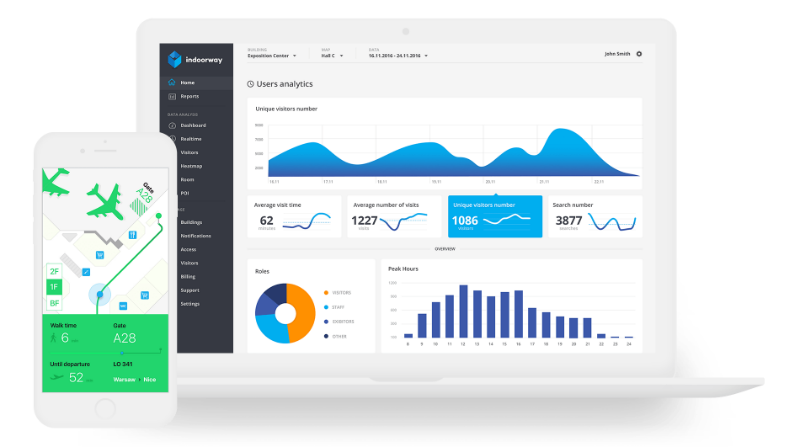Engineers who tame the space
We can effortlessly find a specific building using modern technologies, but how can we move about an office building several dozen storeys high, a multi-level shopping mall, or a tenement house full of nooks and crannies? A group of specialists, mostly composed of graduates and students of the Warsaw University of Technology, knows how to solve this problem.
Everything began a few years ago, at the WUT’s Faculty of Electronics and Information Technology. Konrad Stanik decided to tackle the issue of room localisation. Research works have been carried for two years under the auspices of MuGEd Students Science Circle. The project was further developed in his engineering and master’s theses. It was the beginning of Indoorway. Today, the company employs 9 people, including 6 students or graduates of the University: Grzegorz Koblański (CEO, graduate of the Division of Mechanics at the Faculty of Power and Aeronautical Engineering), Michał Małkowski (doctoral student at the Faculty of Electrical Engineering), Robert Sobolewski (student at the Faculty of Electronics and Information Technology), Maciej Kozłowski (student of the Division of Mechanics at the Faculty of Power and Aeronautical Engineering), Patryk Pastewski (student at the Faculty of Mathematics and Information Science), and Marcin Jeleński (student at the Faculty of Electronics and Information Technology).
To find a way
“We are developing a tool analysing movements in rooms”, says Marcin Jeleński. “With its help, we can study where people can be most often found in a given building, and assist them in moving from one place to another”.
How does it work? “When we have a plan of the building, we create its outline, which is then basically directly sent to the application”, explains Marcin Jeleński. “We place beacons in the rooms, typically one per 50 m2. They are small devices of the size of a credit card that use Bluetooth to broadcast the signal. We can read this signal using cell phones or tablets. If we know signal strengths, we can determine the location. After deploying the beacons, we have to make measurements, that is, walk the paths that people using our application will walk on”.
The group continuously strives to obtain the most accurate measurements. So far, they managed to reach the accuracy of up to 0.5–2 m. “It’s a really good result”, says Marcin Jeleński.
Feng Shui 2.0
The solution created by Indoorway may prove to be very useful in shopping malls or at universities. Companies can also take advantage of this technology. Corporations require more and more information about the space they utilize. “Analysing information about people moving inside a given building teaches us many things”, says Marcin Jeleński. “We can learn where employees typically gather and spend time, which places are interesting to them, and which are not, what helps them in locating e.g. a rest and refreshment room. Our discussions also indicate that there are situations where someone places a large box somewhere in the factory, which obstructs movement, but nobody speaks about it. If we count all the seconds that employees take to navigate around the obstacle, it will add up to several days, or even a week. This means large savings for a company”.
The solution can largely facilitate managing buildings, and it can also cut down on time needed to search for a person required in a difficult situation, during a crisis, or in case of imminent threat. Such cases include failures, accidents, or break-ins. There is no shortage of ideas for other uses of the application. Library-goers, spending long minutes looking for an interesting book, could take advantage of the technology. The application would lead them to the shelf they’re looking for. Travellers would also gain a lot, as they are often lost at stations or airports. The creators of this idea also think about helping the disabled – the application would direct them to lifts or ramps.
Ready for action
The solution is ready for implementation. The only thing left, are buildings where it could be installed. Indoorway employees have been talking with various companies. To date, the project was met with the interest of, among other entities, site administrators, manufacturers with large factory floors, exhibition organizers. Talks with shopping centres are also underway. Many centres try to implement similar solutions on their own but, according to Marcin Jeleński, Indoorway proposes significant upgrades in this regard.
The company has already marketed several solutions, including a trade fair support application (AdFairs), and DaftCode office applications. They even developed an office PacMan, which requires a great deal of stamina! Users compete for points while running from virtual ghosts.
Marcin Jeleński also states, referencing the origin of Indoorway, that students of the WUT’s Faculty of Electronics and Information Technology have many interesting and valuable ideas. “Everyone is trying to do something”, he says. “We are an example proving that it’s a good idea to continue such university projects, because they may result in something interesting”. More so, since developing IT projects doesn’t cost much, you often just have to try.
Agnieszka Kapela
Office for Promotion and Information









